Our Environment
Owned Vehicles and Contract Transportation
Together, the Postal Service and its transportation partners travel nearly 8 billion miles a year to ensure prompt and reliable mail delivery to every mailbox in the nation.
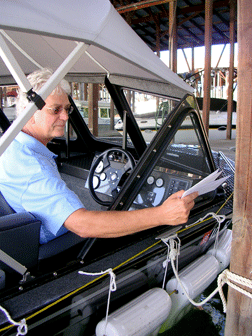
Rural Carrier David Moseley delivers mail dockside for his customers on Lake Coeur D’Alene, ID.
In 2008, moving the mail consumed an estimated 728 million gallons of gasoline equivalent (GGE) across our postal-owned and contract vehicle fleets. The majority was consumed by our contract transportation partners and rural route carriers, totaling 580 million GGE, or 80 percent. The remaining 20 percent, or 148 million GGE, was used by our owned fleet.
Overall Postal Service and third-party provider fuel use actually has declined slightly, about 6 percent, since 2005 ― although fuel use in our owned vehicles has actually increased slightly. The overall decline in fuel use can be attributed to reduced mail volumes and our fuel reduction efforts.
Between 2007 and 2008, the amount of mail delivered by the Postal Service dropped to 203 billion from 212 billion pieces. This reduction in volume also reduced the number of miles traveled and gallons of fuel used to transport mail by air and ground.
By improving the performance of our own vehicle fleet, monitoring our fuel expenditures and seeking the best value from contract transportation partners, we’re striving to reduce fuel consumption and use the most efficient transportation options possible.
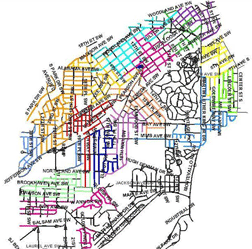
Carrier Optimal Routing
We continue to document energy impacts of our logistics decisions. For example, carrier optimal routing (COR) improves both logistics and energy efficiency. COR uses a detailed mapping system to create more fuel-efficient and safer delivery routes.
In fact, we already use a wide range of transportation options to deliver the mail. Our own vehicles are primarily focused on mail delivery. We rely on an extensive network of contract partners to move mail behind the scenes, by air, highway, rail and water.
Some of our rural route employees deliver mail using their own private vehicles. Other carriers deliver by boat, foot, bicycle and, in the Grand Canyon, by mule.
We’re focusing our fuel-reduction efforts on postal-owned delivery, collection and service vehicles. By 2015, we’re targeting an overall reduction in petroleum use of 20 percent from a 2005 baseline.
We also plan to increase use of alternative fuels, including electricity, E-85, biodiesel, propane and compressed natural gas. Our goal is to increase use of these non-petroleum fuels by 10 percent by 2015 from a 2005 baseline.
The science of measuring environmental and economic impacts of various alternative fuels is evolving, so we’ll continue to evaluate the right mix of these fuels in our operations as we gain more experience with them.
Given our universal service obligation and other distinct constraints, meeting these goals will be a challenge. However, by closely monitoring our fuel use, using shortest routes for moving the mail and investing in alternative-fuel vehicles, we hope to exceed our goals and serve as an example for other agencies.
Also, by closely monitoring fuel use and related spending, we can react faster to fluctuating fuel prices and plan our capital investments for fuel efficiency more effectively.
Several other measures are under consideration that can be implemented quickly and economically. These include reducing the number of non-mail hauling vehicles, conducting more route inspections and reductions, placing vehicles with low fuel economy on the shortest routes and continued investment in GPS technology to track vehicle movements.
We’ve also developed a long-term fuel strategy that reduces costs and risks by working more collaboratively with suppliers to manage our fuel supply.
Owned Vehicles
Owned Vehicle and Contract Transportation Energy Use
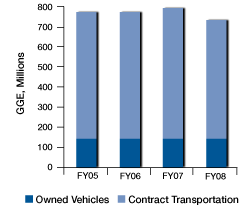
The Postal Service closely manages the performance of our owned vehicle fleet. In 2008, we used an estimated 148 million GGE of petroleum-based fuels and 1.51 million GGE of alternative fuels, such as biodiesel and compressed natural gas. In this subset of the total fleet carrying mail, we aren’t progressing toward our goal of reducing petroleum use. Petroleum-based fuel use by our owned vehicle fleet actually increased approximately 4 percent between 2005 and 2008.
Because we deliver mail to more addresses each year, our owned vehicles continue to drive greater distances and consume more fuel, largely accounting for the increase. In 2008, the Postal Service reached 3 percent more delivery points than in 2005.
While we’re progressing toward our goal of using alternative fuels in more vehicles, actual alternative fuel purchases make up only a small percentage ― 1 percent in 2008 ― of total fuel purchased for our delivery, collection and service vehicles. While we’ve purchased more than 11,000 E-85-capable vehicles since 2005 in accordance with federal law, the lack of E-85 fueling stations requires us to use traditional fuels in these vehicles.
Owned Vehicle Energy Use by Fuel Type
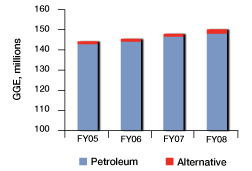
Vehicle Fuel Management
USPS plans to reduce petroleum use in our owned vehicles, while absorbing more than 1 million new delivery locations each year.
Computer modeling is helping our delivery managers devise more efficient routes to minimize fuel use. Individual mail carriers also are incorporating best practices to reduce vehicle idling, which can be significant given the frequent starts and stops required on routes. Other improvements include increasing the number of deliveries per route and consolidating infrequent trips.
Alternative Fuels
The Postal Service operates one of the nation’s largest fleets of alternative fuel capable vehicles, including more than 37,000 E-85 flex-fuel vehicles that can operate on gasoline, E-85 or any mixture of the two fuels. However, as mentioned earlier, most of these vehicles run on standard petroleum-based fuels because there are currently so few E-85 fueling stations.
Owned Vehicle Alternative Fuel Use

To add flexibility in the future, we’re currently supporting several initiatives to lessen our dependence on fossil fuels. In 2008, we signed an agreement with General Motors to test the fourth-generation hydrogen fuel cell Chevrolet Equinox. This vehicle currently is being used to deliver mail in Irvine, CA, and a second Equinox is being deployed in the Washington, DC, area.
The Postal Service is working with other partners to test electric and hybrid vehicles that could supplement our existing delivery fleet. For example, we purchased several three-wheeled electric delivery vehicles in 2008 to deliver mail on shorter routes in Florida, California, Texas and Arizona.
|
USPS has one of the largest alternative fuel capable vehicle fleets in the world. |

|
We also are testing two hybrid electric two-ton vehicles at Huntington Station Post Office in New York. One was converted to hybrid electric technology by Eaton Corp. and the other is a new hybrid electric vehicle from Azure Dynamics.
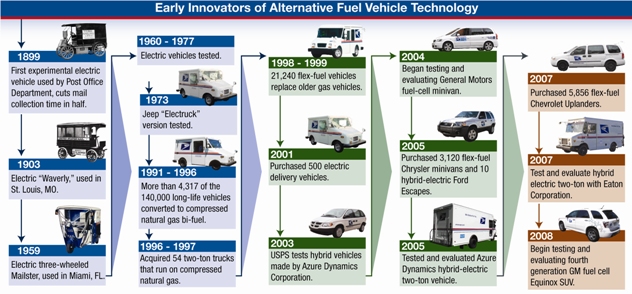
Research and Development
Our alternative fuel vehicle program is part of a larger effort to reduce uncertainty and risk by testing a variety of technologies that use alternative fuels.
Our research and development strategy is to test these vehicles under real operational conditions to determine their potential value to our operations, including fuel and maintenance costs, as well as overall environmental impact. These R&D initiatives help us make informed, reliable decisions regarding fleet replacement and new vehicle technologies.
Contract Transportation
Contract Transportation Energy Use
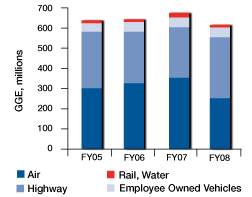
Our primary goal for USPS contract transportation partners is to make sure they maintain quality service at the best value. In 2008, our contract transportation partners used 289 million GGE for highway and 245 million GGE for air to transport USPS mail.
USPS employees operating their own vehicles used an additional 41 million GGE, and the remaining categories—rail and water—totaled 5 million GGE.
Since 2005, total fuel use for mail transport by contract transportation providers has dropped 8 percent. This decline is due in large part to the 15 percent drop in air transport that coincided with the loss of mail volume between 2007 and 2008.
As we continue to reduce the overall environmental impact of our operations, we’ll work to meet our service commitments using surface, rather than air, transportation to reduce fuel use.
It is About the Bike
Our “fleet of feet” isn’t just about the more than 10,000 letter carriers who walk their routes every day—it’s about those who ride them as well.

Sun City, AZ, Letter Carrier Terry Hesselrode is one of nearly 70 letter carriers across the country who deliver mail on a bicycle.
Three Post Offices across the country boast pedal-powered routes—Sun City, AZ, Miami Beach, FL, and the Open Air Station in St. Petersburg, FL. Sun City has 37 routes, while Miami Beach and St. Petersburg each have 16 routes. Bike routes help USPS lessen dependence on oil, reduce our carbon footprint and lower greenhouse gas emissions—three key goals of our environmentally oriented business model.
Sun City, AZ, carriers delivering by bicycle conserve 7,800 gallons of gasoline annually compared to Long Life Vehicle delivery and eliminate 25,000 pounds of carbon dioxide emissions. All Sun City carriers with bike routes received new wheels in November of 2007. Sun City, AZ, Postmaster Mark Strong said, “Now our red, white and blue fleet of bicycles is delivering green.”
The program has been so successful that USPS is looking at opportunities to create more eco-friendly — and heart healthy — bike routes.
|
|
|
